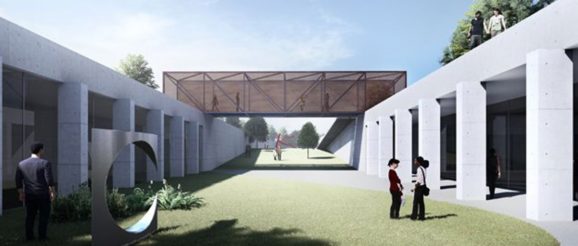carlos moubarak adds innovation center to niemeyer campus in lebanon

architect carlos moubarak’s proposal for the knowledge and innovation center engages in a refined dialogue with one of oscar niemeyer’s modernist masterpieces. the new project is a business service and technology park located in tripoli, lebanon within the RKIF campus designed by niemeyer in the 1960s. the project had to stay true to niemeyer’s vision of a place of social integration that is open to all.
in the highly sensitive environment, moubarak’s objective was to achieve a delicate yet balanced proposal that preserves the site’s integrity while meeting the new program’s requirements. envisioned as a seamlessly embedded part of the RKIF site, the project is designed as an inhabited green park and aims to be an absolute fusion of architecture and landscape.
minimizing the project’s impact above ground, the subterranean architecture preserves the sacrosanct visual field that connects all of niemeyer’s structures. the architecture also acts as an observation post on them. in contrast, the few emerging constructions placed on the site’s edges take abstract forms and function as counterpoints.
the new proposal adopts the balance and contrast approach in regard to niemeyer’s tonic architecture. the project aspires to a ‘degree zero’ in its expression whose intended neutrality and reduced material palette are meant to highlight the existing structures. on the other hand and more fundamentally, the design adopts niemeyer’s distinct binary opposition as a compositional system throughout the whole scheme.
reproducing the harmony of a natural ecosystem, the project is a combination of synthetic and biological, active and passive, technological and natural systems working in synergy. moreover, the blend of hardscape (pathways, piazza, outdoor ramps and stairs) and softscape (lawns, extensive green roofs, native plants and trees) offers the visitors and users a diversified and multisensory experience.
mirroring in subtraction the existing boomerang floating structure, the green canyon constitutes the spinal column to which most of the program’s new components are connected. it acts as a green lung for the underground functions while additional linear gardens, successions of courtyards and other lateral openings complete the efficient ventilation and natural lighting systems of the subterranean architecture.
acting as the focal garden and central meeting place, the green canyon also becomes the stage for corporate and cultural events, permanent artworks and temporary exhibitions. structured by the void, the project displays a series of connected underground open spaces that kindle people’s interactions and form the canvas for inspirational workplaces. this porosity, extending to the park’s network that is also open to the general public, makes the knowledge and innovation center an overall interactive business, social and cultural infrastructure.
conceived as a synergy of systems, the project’s holistic approach combines the various spatial, formal, material, technical, economical, environmental and social considerations into an integrated cost-effective design solution. moubarak intends for the project to be delicately infused with Niemeyer’s spirit, architectural purity, constructive discipline, distinctive spatial experiences, binary opposition principles and yet to have the neutral expression that never disrupts the eloquent existing structures and the integrity of the site. In fine, it is the project’s greatest ambition to live up to Niemeyer’s legacy by being the coda to his unfinished symphony.
project info:
project name: knowledge and innovation centr
designboom has received this project from our ‘DIY submissions‘ feature, where we welcome our readers to submit their own work for publication. see more project submissions from our readers here.
edited by: cristina gomez | designboom
